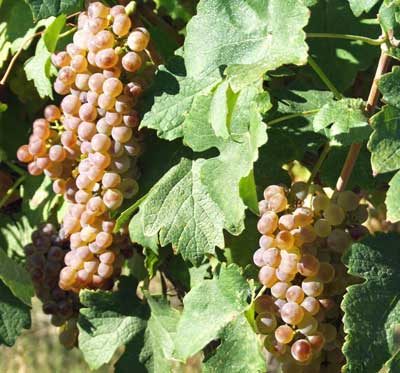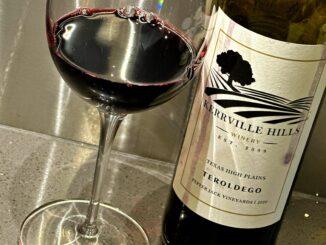When You Have Texas Roussanne, Who Needs Chardonnay
Roussanne is a variety of Vitis Vinifera with yellow-green colored berries, which gain a rosey hue under sunny conditions, that originated from France. It has several common names depending on where it is grown. These names include: Barbin, Bergeron, Martin Cot, Fromental, Fromental Jaune, Fromenteua, Rebolot, Babellot, Ramoulette, Remoulette, Greffou, Picotin Blanc, and Courtoisie. In Texas, we just call it, a really good grape that loves our state as it’s adopted home.
From the Horse’s Mouth….
According to Bobby Cox, Texas High Plains Viticulturalist Extraordinaire, “Up here, WOW! What a grape…late bud break, great wine and plenty of it per acre. The word of the day with respect to Roussanne is ‘texture’. A good Roussanne is like silk on your palate. It can also combine with Viognier to produce an aroma in a wine like you wouldn’t believe.”
Getting to Know a New Friend
For a bit of history and background on this new Texas varietal, Roussanne derives from the Rhône Valley region of France where it is thought to have originated in the middle valley. In the mid-twentieth century, Roussanne was planted in newer areas in the Cotes du Rhône located in the southern Rhône Valley where it’s frequently blended with other local white varieties. It is also planted in Lucca, Italy, and Australia. So, call it a French varietal, call it an Italian varietal, call it an Australian varietal, but now we can call it a Texas varietal.
In new world locations, Roussanne is notorious for budbreak about a week after Chardonnay and Viognier. In Texas, for white grapes particularly, every week is critical in resisting late spring freeze damage. This is one of the reasons why growers have high expectations for it here.
Besides its late bud break characteristics, Roussanne also likes Texas because of our warm, sunny climate. It does best on well-drained, low fertility soils with calcareous material (do I hear… famous Texas High Plains terroir composed of red sandy loam over porous caliche limestone?). The Texas High Plains AVA has been the primary location for many of the Roussanne plantings in Texas, where elevation, normally arid conditions and intense sunlight provide conditions for good ripening and successful cultivation.
A Supporting Actor in France, a Star Player in Texas
In France, Roussanne is mainly known as a blending grape, especially with Marsanne. In Texas, with its short but interesting history, Roussanne has been made as a single varietal wine, although you can find some being used in Mediterranean-style and aromatic white blends. The wine descriptors for Roussanne typically include floral, honey, apricot, and sometimes mineral, good acidity and structure, and a particularly strong floral component. Roussanne can be fermented in stainless steel tanks and is often bottled directly without oak aging for making intense fruit-driven wines. I experienced this style in one of my Pick Six wines from 2009 that I poured at the Grand Wine and Food Affair (https://vintagetexas.com/?p=738).
The Proof is in the Pudding
Texas Hills Vineyard (www.texashillsvineyard.com) Roussanne 2007 – This wine is pale straw in color but carries, rich citrus and peach blossom aromas and similar flavors; ripe yet light and crisp character from time spent hanging in the intense sun, but kissed with cool nights. One of the attendees at the Grand tasting said, “Wow, it’s like a Sauvignon Blanc on Steroids!”
With secondary malolatic fermentation and oak aging, Roussanne provides a silky, smooth old-world tasting experience, something that nearly every Chardonnay drinker should appreciate. An example of this style of Roussanne is the Becker Vineyards (www.beckervineyards.com) Roussanne 2009 (Texas High Plains; Bingham Family Vineyards – www.binghamfamilyvineyards.com). I presented this wine at the George Bush Presidential Library last month (https://vintagetexas.com/?p=1733), praised it for its gracefully smooth mouthfeel and floral aromatics, and tasted it again last night. It was yellow gold in the glass, rich, smooth and flavorful on the palate, and a fulfilling companion to my garlicky pasta dish at dinner.
Follow the Leaders
Other winemakers are joining the Texas Roussanne revolution, too. Howard Davies at Arche (www.ArcheWines.com) in Montague County, has been growing it for 10 years to see how it was going to handle the north Texas terroir. His 2009 vintage wine is unoaked full varietal wine and offers a crisp, fruit-forward style. Howard likes this grape and word has it that he will be planting more. Jim Johnson at Alamosa Wine Cellars (www.alamosawinecellars.com) uses Roussanne in a classic European style blend called Scissortail that combines it in partnership with Viognier and Marsanne, two white grapes that originate from southern France, that he received from nearby Cherokee Creek Vineyards. Seth and Laura Martin at Perissos Vineyard and Winery (www.perissosvineyards.com) makes a Roussanne Blend that combines Roussanne, with a collage of grapes including Chenin Blanc, Muscat, and Viognier to make an golden yellow wine that yields aromas of peaches and apricots.
Like I said at the start….”When You Have Texas Roussanne, Who Needs Chardonnay!



Great post Russ! Texas is doing some really amazing things with some white varieties. I have found some outstanding examples of Roussanne, Viognier, and Chenin Blanc, just to name a few.
This post was incredibly educational, which is great for a variety that is probably not as well known as some.
Another “not so well known” grape varietal that seems like its found a great fit here Russ. I love the pioneering efforts of these growers and producers. Rousanne has relatively little commercial availability/appeal in the US compared to Chardonnay, but it is efforts like these that will help define the Texas wine industry in years to come. I particularly find the late bud break to be a significant charactersitic that should be appealling to growers.
Great post Russ! Up here on The High Plains that “rosey hue” can get pretty dark at over 3000 ft elevation. More than once I have received a panic call from a Roussanne grower “my grapes have turned BROWN”. Think of making etouffee The butter and flour are cooked until brown making a roux. Same word, brown sauce, brown grape. In either case the taste is great!
Very tasty, very informative post. I plan on sourcing one of the Roussannes mentioned for my Texas Wine Club subscribers this week. Thanks!
Cheers!